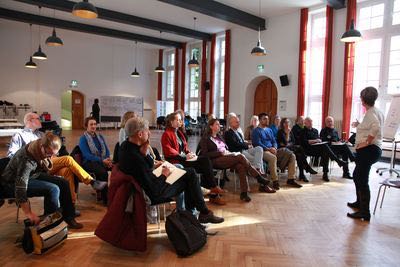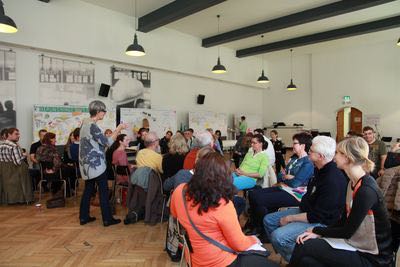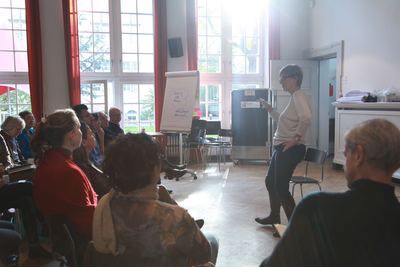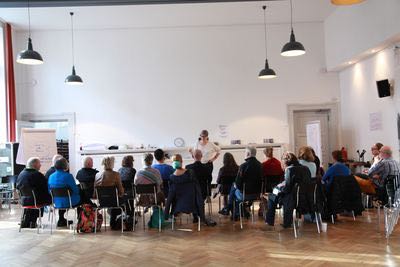Provocative coaching and change: Can you make things better by making them worse? It is analogous to making a donkey move forward by pulling his tail. The approach of “Provocative Coaching” was developed by Frank Farrelly when he realized that friends often uplift and nudge you. Coaches and consultants, on the other hand, seem to take a solemn approach to issues, but they’re not necessarily effective in bringing about change. For me, it was refreshing to attend this Provocative Change workshop.
Farrelly recognized that laughter and humor are key ingredients in the success stories of many leaders, parents, and partners. His work has taught many professionals to identify the right time to switch style and to work in a way that appears to fly in the face of everything they have learned.
“Coaching with humor aims to change your thinking, perspective, and state by stimulating you to react and defend what is positive about your position rather than focusing on what is negative. The aim is to provoke a healing, resourceful response.” Talking is Sue Knight, an international consultant teaching NLP in business, who guided a short workshop during the Berlin Change Days conference. Here’s my coverage of this refreshing workshop for coaches and consultants.
Do it with love
I experience how I’ve become accustomed to my own ways of working with people: taking things seriously, making sure to create enough safety for them to speak up, taking care not to hurt them – nudging them towards insights and new behaviors… I hear the same from others – while we practice provocative coaching, we experience our own assumptions, prejudice and reserve at going beyond what is “normal”.
“You can’t laugh at your client in their face, can you?!” Well, not laugh at them, but you can laugh with them if you do it with love, skill, good timing and the purpose to help them see their issue more clearly.
“Humor is a quick way to build rapport”, explains Knight. “You provoke the client to become aware of how they think and act – but it is important that you do it with love.”
Love is the ultimate rapport, or connection. You can be tough and very clear – as long as you do it with love. To me, love means understanding, respect, non-judgmental attention, complete honesty and clarity (which can be painful) plus my willingness and efforts to serve my client the best I can.
 The goal is not to make people uncomfortable, or humiliate, or offend them (though that’s likely to happen with this change approach). The goal is to provoke a healing response. The goal of working with a client, whether it’s a person or an organization, is learning.
The goal is not to make people uncomfortable, or humiliate, or offend them (though that’s likely to happen with this change approach). The goal is to provoke a healing response. The goal of working with a client, whether it’s a person or an organization, is learning.
Seeing with fresh eyes
“Content is verbal and already known. I advise you to not get drawn into the story the client tells. Instead, look at how they are and who they are. The information you need to help them get unstuck is IN the process. Look for nonverbal cues. Don’t always listen to what the client says! But keep your attention with them completely: notice their nonverbal communication, and their patterns of telling their story, their patterns of behaving. The key is to interrupt their patterns – to distract them – to take them out of their current state of mind – to help them see the situation with fresh eyes and wake up and learn.”
Practice, and practice more
After this short introduction of provocative coaching, we practice in pairs – coaching one another in turns of 5 minutes. “Tell me, what’s your issue?”
My first practice partner tells me he’s too busy and he hates it – but it’s too hard to say no to everyone.
It is important to first check my own state: to notice what I notice about them. I check my loving-kindness, my willingness to serve. And I notice myself leaning in – I am seduced by the content of what he’s telling me because I recognize this.
I’d better check what his nonverbal signs convey. How does he really feel about this issue? He smiles a lot. I start teasing him “with love”. I interrupt him, saying: “Ah, you’re too good to be true. I can see how hard it is to be so competent that everyone needs you all the time.” We end up laughing about the issue – though we don’t get to the core of it – because time’s up. But then again – maybe we did. Sometimes the fact that people can laugh at their issue is all the change required as Sue assures us.
 My next client complains that her boss is not present. He’s too busy to help, or he’s not there when she needs him. Looking at her it strikes me that she herself is not present in her body. Her hands are cold, she looks feeble, she hangs in her chair, her eyes scan the room. I start to interrupt her briskly. “But are you present? Where are you now?” I end up asking her whether she’d need her boss at all if she herself would be fully present at work? It provides a new insight – within 5 minutes.
My next client complains that her boss is not present. He’s too busy to help, or he’s not there when she needs him. Looking at her it strikes me that she herself is not present in her body. Her hands are cold, she looks feeble, she hangs in her chair, her eyes scan the room. I start to interrupt her briskly. “But are you present? Where are you now?” I end up asking her whether she’d need her boss at all if she herself would be fully present at work? It provides a new insight – within 5 minutes.
Tips to prod and provoke
In between turns, Sue Knight gives us advice and mocks us with loving humor whenever necessary. It makes us laugh at ourselves who are seriously trying to master this uncomfortable skill of “poking and interrupting” people to wake them up…
“If you want to provoke a response and you don’t seem to succeed – think of topics like money, death or sex. We have so many taboos associated with these!”
Or: “Mirror their physical body posture, make it a caricature if you like – to elicit a response.”
“Mishear their name on purpose – and then make fun of it. People are attached to their names – so that will give you a reaction and it signifies that you are prepared to work with change at the level of identity. Once they react – you can engage.”
“When you’re thinking what to do next – you’re away from the present. Stay aware in the here and now with your client.”
My third client sighs about her long-term goals that she never achieves. She’s busy with her current situation – postponing what she must do to reach those long-term goals. I prod until she admits that she feels cozy. “It is easier to play with the cat instead of building a bigger consulting business.” “Well, then you’re all set!” is my conclusion. “You don’t really want a bigger business. You want to relax on the couch and make just enough money to get by.” It shocks her – she was convinced she truly wanted to build her business.
Let the client do the work
Sue Knight shares what John Grinder (one of the NLP gurus) called the three demons that jeopardize a person’s effectiveness: muscle tension, inner noise and tunnel vision. “If you have any muscle tension, you are blocking your potential in some way.” That’s why humor is so important: for laughter, we have to let go of tension. We can’t think when we laugh.
 Exaggerating is another way to prod the client. “So, you don’t want to get off the couch? Ever? You’re really lazy, aren’t you?” But what if the client believes you when you exaggerate like this? Knight bursts out in laughter. “Then they have a new problem! That’s nice for a change.” But seriously, the key is to change their inner state. When they change their state of mind, they can access other insights and resources.
Exaggerating is another way to prod the client. “So, you don’t want to get off the couch? Ever? You’re really lazy, aren’t you?” But what if the client believes you when you exaggerate like this? Knight bursts out in laughter. “Then they have a new problem! That’s nice for a change.” But seriously, the key is to change their inner state. When they change their state of mind, they can access other insights and resources.
Likewise, mishearing what they say or getting it wrong on purpose is a way to help them find what IS true.
We are reminded to let the client do the work. Don’t save them, don’t give them advice. Or if you give advice, do it in an exaggerated way. To give ridiculous advice is one of the strategies – to make people think for themselves.
Go with whatever works to help them become aware of their own issue – and find their own resources to change it.
I coach three people and I’m being coached by three different people – and they are all unique. Their energy, their approach, their states of mind – the questions that work well for one person that don’t elicit a response with the other… Everything is different with each individual.
I’m too busy – and okay!
Next, I am coached by three other people who differ in their approach – coming at my issue from different angles. My issue is that I’m too busy – and too tired because I love doing everything I do – and I keep asking too much from my poor body. Shouldn’t I buy a cottage in Southern France to get away from it all and relax? (A nice dream).
My second coach shakes her head and concludes after some prodding that I’m too busy to have issues – and for that reason, also too busy to have a cottage in France. Problem solved. I laugh wholeheartedly at myself – this is a great outcome and I can see the humor.
Another coach has a different angle: since I’m from the Netherlands, a country below sea level, I must be used to being flooded. I must know how to keep myself from drowning or I won’t be a true Dutchie. Thank you – the image of staying afloat on top of the workload feels fine! I can do that. I can surf this wave!
We laugh a lot during this workshop, but we also work hard. We have to be very alert, watching for nonverbal cues, responding creatively to bust the wall around people, to push through the story and reveal the resources they can use to solve it. Or to get any response at all… It makes you awake and aware.
 Sue Knight creates the context in which we can practice what is uncomfortable and sometimes impolite to do. But it surely is effective! Many of us have found little gems of insight in these 5-minute coaching sessions.
Sue Knight creates the context in which we can practice what is uncomfortable and sometimes impolite to do. But it surely is effective! Many of us have found little gems of insight in these 5-minute coaching sessions.
Caution for readers: don’t try this at home, or out of the blue with your clients. Practice your skills first and create a context that is clear for all people involved: what is happening and why.
To serve the client and nothing but the client – we must provoke a resourceful response – to let them find and appreciate what is true and what is helpful in their change process.
Sue Knight is an international consultant and author of “NLP at Work”. She teaches the use of NLP (Neuro Linguistic Programming) in business. She can be reached via https://www.sueknight.com/ Before the Berlin Change Days conference in 2015, she’ll guide a 2-day workshop.
Photography by Brindusa Ioana Natasa.
Marcella Bremer is an author and culture & change consultant. She co-founded this blog and ocai-online.com.
